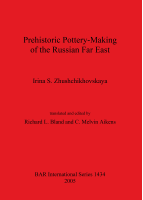Description
BOOK DESCRIPTIONDr. Zhushchikovskaya is a member of the Russian Academy of Sciences, Far Eastern Division, Vladivostok. This is an original work of synthesis, expressly written for an international audience and not previously published in Russian. Before the research ofquite recent years, the Incipient Jomon pottery vessels of Japan had clear claim to the distinction of being first in the world, with an age of about 13,000 radiocarbon years, or close to 15,000 calendar years ago. Now many comparably early dates have appeared in the Russian Far East as well, and impressive though currently less well-documented dates for early pottery are also appearing in China, Korea, and other countries. The present work shows that it may be quite some time now before any question of first can be resolved, as continuing discoveries show quite comparably early pottery appearing over an increasingly broad front in eastern Asia. Obviously there were processes at work that were general in scope, and certainly not accidental. Zhushchikovskaya goes to the heart of this matter with her synthesis of the current evidence from the Russian Far East, which pays close attention to the environmental circumstances in which early pottery appears. Equally, she pays close attention to the properties of raw materials and the mechanics of shaping and firing. Ethnographic observations on aboriginal pottery-making and other craft processes contribute importantly as well. Zhushchikovskaya's account of the earliest pottery is only the beginning of her work. In later chapters she goes on to trace the development of the early Russian traditions down through additional millennia of environmental and cultural change to the Iron Age, addressing the relations of pottery-making to socio-economic structures, andthe range of structures reflected in pottery-making itself. Her concluding discussion sums up the implications of particular Russian evidence for understanding the role that the study of pottery-making plays in archaeologists' efforts to trace cultural continuities and discontinuities, periodization, tempo of cultural development, cultural contacts, and migrations. This book will be of interest to a broad cross-section of readers: those interested in the history, technology, and functions of pottery; those who will appreciate the attention it pays to ecology, context and process in the innovation and diversification of traditions; those who seek to expand the utility of pottery as a tool in archaeological synthesis and interpretation; and those who pursue specific interests in the cultural history of eastern Asia. It also offers the international community an interesting window on some of the ways in which Russian archaeologists conceptualize their subject matter.











